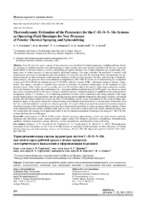| dc.contributor.author | Gorbunov, A. V. | |
| dc.contributor.author | Devoino, O. G. | |
| dc.contributor.author | Gorbunova, V. A. | |
| dc.contributor.author | Yatskevitch, O. K. | |
| dc.contributor.author | Koval, V. A. | |
| dc.coverage.spatial | Минск | ru |
| dc.date.accessioned | 2021-10-06T12:02:51Z | |
| dc.date.available | 2021-10-06T12:02:51Z | |
| dc.date.issued | 2021 | |
| dc.identifier.citation | Thermodynamic Estimation of the Parameters for the C–H–O–N–Me-Systems as Operating Fluid Simulants for New Processes of Powder Thermal Spraying and Spheroidizing = Термодинамическая оценка параметров систем C–H–O–N–Me как имитаторов рабочей среды в новых процессах газотермического напыления и сфероидизации порошков / A. V. Gorbunov [et al.] // Наука и техника. – 2021. – № 5. – С. 390-398. | ru |
| dc.identifier.uri | https://rep.bntu.by/handle/data/103441 | |
| dc.description.abstract | Over the past few years, a group of new processes was developed for high-temperature, including plasma electric arc spraying (at ambient pressure) and spheroidizing of some ceramic and metal powder materials with the use of gaseous hydrocarbons in the heat carriers as well as with feeding of organic additions into a high-temperature jet, in particular, polymeric ones, to control porosity of sprayed metallic functional coatings. The paper considers the possibility to modify such technological processes by introducing solid fuel additions of a polymer type into the operating fluid of an apparatus for gas-thermal (plasma or other) treatment, which provides melting of metal or oxide powders. For this, with the help of thermodynamic analysis, the processes have been evaluated at temperatures (300–3000) K for the set of such reacting five component systems as C–H–O–N–Me (at ambient pressure 0.101 MPa) with five variants of Ме – aluminum, titanium, chrome, copper, nickel. This makes it possible to consider these systems as simulants for potential technologies for the treatment of oxide powders (Al2O3, TiO2, Cr2O3) as well as metallic ones (Cu, Ni and their alloys). In order to obtain high exothermic contribution to the heating of powders, the combination “air + polymeric addition (polyethylene) of LDPE grade” was chosen as mixed heat carrier (operating fluid) for the basic version of simulated process. During the analysis of equilibria for the considered multicomponent systems (17 variants), a set of following parameters has been used to characterize the energy intensity of the target powder heating process: the equivalence ratio for reacting mixture and its adiabatic temperature; the energy efficiency of material heating with and without taking into account the effect of fuel addition; specific energy consumption for the powder melting; auto-thermicity degree of the process during the combined heating (electrothermal heating by the arc of plasma torch and heat flux from the “air + solid fuel additions” mixture) of refractory powders. As a result of the assessment, the preferred (from thermodynamic standpoint) regimes of the considered processes have been found and the possibility to realize an energy-efficient heating of these oxide and metal materials (without oxidation of the latter to CuOx, NiO) with a reduced part of the electric channel of energy transfer, resulted from the carrying out of appreciable effect of the fuel-initiated mechanism of heating in the analyzed C–H–O–N–Me-systems, has been shown in the paper. | ru |
| dc.language.iso | en | ru |
| dc.publisher | БНТУ | ru |
| dc.title | Thermodynamic Estimation of the Parameters for the C–H–O–N–Me-Systems as Operating Fluid Simulants for New Processes of Powder Thermal Spraying and Spheroidizing | ru |
| dc.title.alternative | Термодинамическая оценка параметров систем C–H–O–N–Me как имитаторов рабочей среды в новых процессах газотермического напыления и сфероидизации порошков | ru |
| dc.type | Article | ru |
| dc.identifier.doi | 10.21122/2227-1031-2021-20-5-390-398 | |
| local.description.annotation | В последнее время ведется разработка группы новых технологий высокотемпературного, в том числе плазменного электродугового, напыления (при атмосферном давлении) и сфероидизации некоторых керамических и металлических порошковых материалов как с использованием углеводородных газов в качестве теплоносителей, так и с внесением в высокотемпературную струю органических добавок (в частности, полимерных) для регулирования пористости напыляемых металлических покрытий. В статье рассмотрена возможность модификации процессов данной группы за счет ввода твердотопливных добавок полимерного типа в рабочую среду аппарата для газотермической (плазменной или другой) обработки, обеспечивающей плавление металлических или оксидных порошков. Для этого с помощью термодинамического анализа проведена оценка процессов при температурах (300–3000) К для набора реагирующих пятикомпонентных систем типа C–H–O–N–Me (при давлении 0,101 МПа) с пятью вариантами Ме – алюминий, титан, хром, медь, никель. Это позволяет рассматривать данные системы как имитаторы для потенциальных технологий обработки как оксидных (Al2O3, TiO2, Cr2O3), так и металлических (Cu, Ni и их сплавы) порошков. С целью получения высокого экзотермического вклада в нагрев порошков в качестве смесевого теплоносителя для базового варианта моделируемого процесса выбрано сочетание «воздух + полимерная добавка (полиэтилен марки LDPE)». В ходе анализа равновесий в рассмотренных многокомпонентных системах (17 вариантов) для характеристики энергоемкости целевого процесса нагрева порошков использовали набор параметров: фактор эквивалентности реакционной смеси и ее адиабатическую температуру, энергетический КПД нагрева материала с учетом и без учета вклада топливной добавки, удельные энергозатраты на плавление порошка, степень автотермичности процесса при комбинированном нагреве (электротермическое нагревание через дугу плазмотрона и тепловыделение от смеси «воздух + твердотопливная добавка») тугоплавких порошков. В результате проведенной оценки найдены предпочтительные (с термодинамических позиций) режимы рассмотренных процессов и показана возможность реализации энергоэффективного нагрева данных оксидных и металлических материалов (без окисления последних до CuOx, NiO) с пониженной долей электрического канала энергопереноса за счет существенного вклада топливного механизма нагрева в C–H–O–N–Me-системах. | ru |

